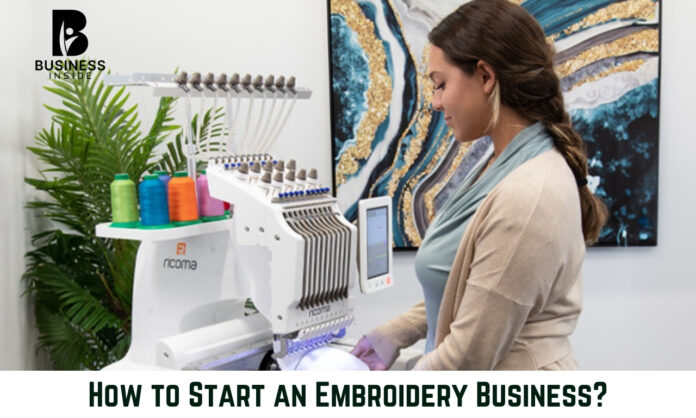Embroidery has long been a cherished art form, transforming simple fabrics into intricate works of art. With the rise of customization in fashion and home decor, embroidery has found a renewed popularity. Starting an embroidery business is a promising venture, offering a blend of creativity and entrepreneurship. This guide will walk you through the steps on how to start an embroidery business, ensuring your success in this creative industry.
Step 1: Research and Business Planning
Every successful business begins with a solid plan. Starting an embroidery business is no different. Begin by researching your target market. Who are your potential customers? Are they businesses looking for custom corporate gifts, or are they individuals seeking unique, personalized clothing? knowing your market will enable you to customize your services to fit their specific needs.
Creating a Business Plan
A business plan is crucial for guiding your business in the right direction. It should include:
• Market Analysis:
Understanding your competitors and identifying your unique selling points (USPs).
• Services Offered:
Defining the range of services you will provide. This could include custom embroidery for apparel, home decor items, corporate gifts, etc.
• Pricing Strategy:
Setting competitive prices that cover your costs and provide a profit margin.
• Marketing Plan:
Outlining how you will attract customers, whether through online advertising, social media, or local events.
• Financial Projections:
Estimating your initial investment, ongoing costs, and expected revenue.
Step 2: Acquiring the Necessary Skills and Equipment
To start an embroidery business, you need to have the right skills. If you’re new to embroidery, consider taking courses to master the basics. Numerous online resources are available, including video tutorials and embroidery classes, that can help you learn at your own pace.
Investing in Equipment
The quality of your embroidery work largely depends on the equipment you use. Key equipment includes:
• Embroidery Machines:
Choose between single-head or multi-head machines depending on the scale of your business. Brands like Brother, Janome, and Singer offer reliable options.
• Software:
Embroidery digitizing software is essential for converting designs into embroidery-ready formats. Popular choices include Wilcom, Hatch, and Embrilliance.
• Supplies:
Stock up on threads, needles, stabilizers, and fabric. The quality of these materials will impact the final product.
Step 3: Setting Up Your Embroidery Workspace
The next step in how to start an embroidery business is setting up your workspace. Whether you plan to run your business from home or a commercial space, your workspace should be organized and efficient.
Home-Based vs. Commercial Workspace
• Home-Based Business:
If you’re starting small, a home-based setup is cost-effective. Ensure you have a dedicated room or area with sufficient space for your equipment and supplies.
• Commercial Space:
As your business grows, you might consider moving to a commercial space. This option offers more room for expansion and the opportunity to serve walk-in customers.
Step 4: Legalizing Your Business
To start an embroidery business legally, you need to take care of the necessary paperwork. This involves registering your business, acquiring the necessary licenses, and grasping the tax obligations.
Registering Your Business
• Choose a Business Name:
Your business name should reflect your brand and the services you offer.
• Licenses and Permits:
Depending on your location, you might require a business license. sales tax permit, or home occupation permit.
Step 5: Developing a Brand Identity
It’s how customers will perceive your embroidery business. Developing a strong brand identity is a critical step in understanding how to start an embroidery business.
Creating a Brand Logo and Website
• Logo Design:
Your logo should be simple, memorable, and representative of your business.
• Website:
A professional website is crucial for displaying your work and drawing in new clients, and processing orders.
• Social Media Presence:
In the digital era, maintaining a robust social media presence is essential Platforms like Instagram, Facebook, and Pinterest are excellent for displaying your embroidery work and connecting with potential customers.
Step 6: Pricing Your Embroidery Services
Pricing is a crucial aspect of running a successful embroidery business. Your prices should reflect the quality of your work, the cost of materials, and the time invested in each project.
Factors to Consider When Pricing
• Material Costs:
Calculate the cost of threads, fabrics, stabilizers, and other supplies.
• Labor Costs:
Consider the time it takes to complete each project. This includes design time, machine setup, and actual embroidery.
• Overhead Costs:
Include costs such as rent, utilities, and equipment maintenance.
• Profit Margin:
Ensure your pricing allows for a healthy profit margin after covering all costs.
Step 7: Marketing and Growing Your Business
Marketing is essential for attracting customers and growing your embroidery business.
Online Marketing
• Social Media:
Regularly post your work on social media platforms.
• SEO:
Optimize your website with relevant keywords like “how to start an embroidery business” and “custom embroidery services” to attract organic traffic.
Offline marketing
• Local Events:
Participate in local craft fairs, trade shows, and markets to showcase your work and network with potential clients.
• Business Cards:
Always carry business cards to hand out to potential customers.
Step 8: Providing Excellent Customer Service
Offering high-quality products and excellent customer service will encourage repeat business and referrals.
Handling Orders and Deliveries
Ensure your order process is smooth and efficient. Provide clear timelines for order completion and delivery. Consider offering multiple delivery options, including in-store pickup, local delivery, and shipping.
After-Sales Service
Check in with customers after delivery to confirm their satisfaction with their purchase. Address any issues promptly and professionally.
Conclusion
Starting an embroidery business is an exciting venture that combines creativity with entrepreneurship. By following the steps outlined in this guide, you can successfully launch and grow your embroidery business. Remember, success in this industry requires not only talent but also careful planning, investment in quality equipment, and a commitment to customer satisfaction. With dedication and passion, your embroidery business can become a thriving enterprise.

